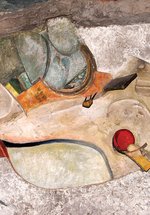Gathering
An architectural installation by collaborators Julia Heslop & Ed Wainwright.
/https://s3-eu-west-1.amazonaws.com/atwam-images-files/production/images/content/hattongallery/2018-08/219459.jpg)
Dates
Until 16 February 2019 (historic exhibition)
About
The final artist intervention takes place on Saturday 16 February - find out more.
Take a look at what interventions have been at Gathering so far...
To accompany Exploding Collage, collaborators Julia Heslop & Ed Wainwright present Gathering, an architectural intervention which is designed to host the work of other artists, as in Kurt Schwitters’ Hannover Merz Bau, which concealed niches dedicated to his artistic heroes. Likewise, Gathering is comprised of an interconnected sequence of ‘grottoes’ assembled from found and given material, each of which will be dedicated to an artist whose work deserves to be reconsidered in relation to collage as an expanded, immersive or time-based practice.
Gathering will host a programme of interventions which will unfold throughout the course of the exhibition. Every fortnight, an invited artist or researcher will dedicate another ‘grotto’ to the work of an avant-garde figure who they consider to have expanded collage towards new potential forms, with an emphasis on those whose radical practice has led to their contribution being less recognised in canonical histories of the medium. Please keep an eye on the Hatton Gallery website and social media channels for updates and more details as these happen.
Currently exhibiting as part of Gathering is Anka Schmid's video work Sophie Dances Anyway.
Other interventions so far have included:
Sonia Allorri, Ruth Hemus, Vaia Paziana
About the artists
Heslop & Wainwright work across the boundaries of art and architecture, recognising the scope of the artist to act as a critical spatial practitioner, in this case questioning who is afforded and who is denied space in histories of collage.
About the Exploding Collage Season
Exploding Collage was a season of exhibitions at the Hatton Gallery inspired by the idea that Kurt Schwitters’ Merz Barn Wall – on permanent display in the Hatton Gallery – is a work of genre exploding collage practice, applying Schwitters’ collage technique on an architectural scale.
Each exhibition in the Exploding Collage season explores how avant-garde artists of the early twentieth century expanded the notion of collage into immersive, often ephemeral, formats, with an emphasis on those whose radical practice has led to their contribution being less recognised in canonical histories of the medium. The exhibitions included, Exploding Collage, Gathering, and The Loud and the Soft Speakers.
About the Merz Barn Wall
The Merz Barn Wall is a fragment of an unfinished artwork created by German artist Kurt Schwitters in a Lake District barn between 1947 and the artist’s death in 1948. Made up of plaster, paint and found objects, the work is emblematic of Schwitters’ interdisciplinary ‘Merz’ practice, which applied the principle of collage to all areas of life, re-contextualising discarded material to create new meanings and forms, whether in poetry, music, sculpture or space.
The Merz Barn Wall is the largest surviving fragment of the four Merzbauten (Merz Buildings) Schwitters began work on. The first Merzbau, made in his apartment in Hanover, Germany, was destroyed by allied bombing in 1943. Parts of his second Merzbau, begun in his holiday home in Hjertøyain, Norway, still survive. His third Merzbau near Oslo was destroyed by fire in 1951.
About the curatorial approach
The Merzbauten’s history of erasure and rebuilding informs the curatorial approach of Exploding Collage, which recognises the heightened risk of radically different artistic practice becoming lost due to the difficulty of preserving and exhibiting it.
Alongside this recognition is an awareness of the dual erasure that often effects the work of pioneering female artists, many of whom have historically been overlooked or actively undermined due to their gender. For instance, many of Schwitters’ female contemporaries were excluded from exhibitions, omitted from fellow artists’ written accounts, not collected by museums, and had their contributions belittled by art historians.
The result is a history of twentieth century avant-garde practice which appears to be dominated by men, even though women’s work was some of the most radical.
Although progress is being made in art history, exhibitions and museums are especially susceptible to perpetuating these historical ‘blindspots’, as it is often impossible to exhibit work by these artists due to gaps in public collections. As such, Exploding Collage seeks to circumnavigate the exhibition’s traditional reliance on historical artworks and objects, instead operating through contemporary artists’ work which carries within it the influence of such avant-garde artists, and testifies to their continued relevance and valued legacy, which can persist independently of the objects themselves.




